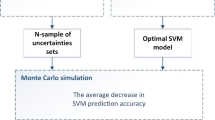Abstract
Polarizers are one of the key parts of Thin-Film Transistor Liquid-Crystal Displays (TFT-LCD), and their production requires high material costs. How to reduce manufacturing costs is thus a key task in this highly competitive global market. The precise yield forecast model considering learning effects that is proposed in this work is believed to be an effective approach to reduce both the raw material input-cost and inventory cost of overproduction. Support vector regression (SVR) model is one of the commonly used approaches to forecast the yield trend. However, in the early manufacturing stages for a new product, an SVR model is usually sensitive and unstable because of the use of insufficient data. Faced with this problem, this research aims at enhancing the SVR model by using past manufacturing experience and virtual samples to estimate the yield trend model for pilot products. This paper proposes a novel Quadratic-Curve Diffusion (QCD) method, wherein we derive a quadratic yield function (QYF) of the new manufacturing process for each key manufacturing variable by utilizing past manufacturing experience; and then use the QYF to generate virtual samples to assist building the overall yield forecast model of the new manufacturing process. The results show that the proposed method is superior to the performance of other forecast and virtual sample generation models.
Similar content being viewed by others
References
Amari S., Wu S. (1999) Improving support vector machine classifiers by modifying kernel functions. Neural Networks 12: 783–789
Anthony M., Biggs N. (1997) Computational learning theory. Cambridge University Press, Cambridge
Chiu C. C., Cook D. F., Pignatiello J. J. Jr., Whittaker A. D. W. (1997) Design of a radial basis function neural network with a radius-modification algorithm using response surface methodology. Journal of Intelligent Manufacturing 8: 117–124
Cook D. F., Shannon R. (1991) A sensitivity analysis of a back-propagation neural network for manufacturing process parameters. Journal of Intelligent Manufacturing 2: 155–164
Cortes C., Vapnik V. (1995) Support vector networks. Machine Learning 20: 273–297
Fan A., Palaniswami M. (2000) Selecting bankruptcy predictors using a support vector machine approach. Proceedings of the International Joint Conference on Neural Networks 6: 354–359
Gestel T.V., Suykens J. A. K., Baestaens D.-E., Lambrechts A., Lanckriet G., Vandaele B., De Moor B., Vandewalle J. (2001) Financial time series prediction using least square support vector machines within the evidence framework. IEEE Transactions Neural Networks 12(4): 809–821
Harville D. (1977) Maximum likelihood approaches to variance component estimation and to related problems. Journal of the American Statistical Association 72: 320–338
Hirschmann W. B. (1964) Profit from the learning curve. Harvard Business Review. doi:10.1225/64107
Huang C., Moraga C. (2004) A diffusion-neural-network for learning from small samples. International Journal of Approximate Reasoning 35: 137–161
Huang Z., Chen H., Hsu C.-J., Chen W.-H., Wu S. (2004) Credit rating analysis with support vector machine and neural networks: A market comparative study. Decision Support Systems 37: 543–558
Jennrich R. I., Schluchter M. D. (1986) Unbalanced repeated-measures models with structured covariance matrices. Biometrics 42: 805–820
Kim K. J. (2003) Financial time series forecasting using support vector machines. Neurocomputing 55: 307–319
Laird N. M., Ware J. H. (1982) Random-effects models for longitudinal data. Biometrics 38: 963–974
Li D. C., Chen L.-S., Lin Y.-S. (2003) Using functioanl virtual population as assistance to learn scheduling knowledge in dynamic manufacturing environments. International Journal of Production Research 41(17): 4011–4021
Li D. C., Wu C. S., Tsai T. I., Chang F. M. (2006) Using mega-fuzzification and data trend estimation in small set learning for early FMS scheduling knowledge. Computers & Operations Research 33: 1857–1869
Liu, H. c. V., Quynh, K. T. N., & Ng, W. K. (2009) Regression models for estimating product life cycle cost. Journal of Intelligent Manufacturing. doi:10.1007/s10845-008-0114-4.
Min J. H., Lee Y. C. (2005) Bankruptcy prediction using support vector machine with optimal choice of kernel parameters. Expert Systems with Applications 28: 603–614
Niyoqi P., Girosi F., Tomaso P. (1998) Incorporating prior information in machine learning by creating virtual examples. Proceedings of the IEEE 86(11): 2196–2209
Radhakrishnan T., Nandan U. (2005) Milling force prediction using regression and neural networks. Journal of Intelligent Manufacturing 16(1): 93–102
Sánchez A., David V. (2003) Advanced support vector machines and kernel methods. Neurocomputing 55: 5–20
Schwarz G. (1978) Estimating the dimensions of a model. Annals of Statistics 6: 461–464
Shawkat A., Kate A., Smith M. (2006) A meta-learning approach to Automatic Kernel Selection for Support Vector Machines. Neurocomputing 70: 173–186
Tsai T.-I, Li D.-C. (2008) Utilize bootstrap in small data set learning for pilot run modeling of manufacturing systems. Expert Systems with Applications 35: 1293–1300
Zoeeiassatine F., Tannock J.D.T. (1998) A review of neural networks for statistical process control. Journal of Intelligent Manufacturing 9: 209–224
Author information
Authors and Affiliations
Corresponding author
Rights and permissions
About this article
Cite this article
Li, DC., Fang, YH., Liu, CW. et al. Using past manufacturing experience to assist building the yield forecast model for new manufacturing processes. J Intell Manuf 23, 857–868 (2012). https://doi.org/10.1007/s10845-010-0442-z
Received:
Accepted:
Published:
Issue Date:
DOI: https://doi.org/10.1007/s10845-010-0442-z




